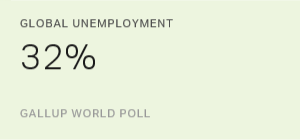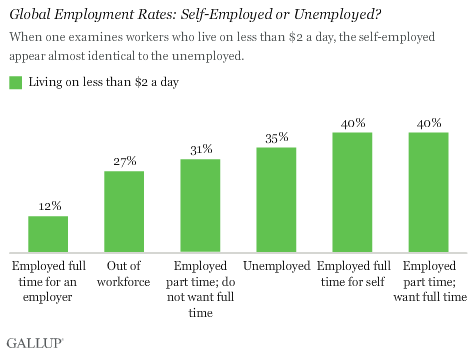Story Highlights
- The most quoted jobs metric in the world is misleading
- Many of the truly unemployed are considered self-employed
- About 3 billion people who want a great job don't have one
What the whole world wants is a good job. That was the breakthrough finding from Gallup's first global survey 10 years ago, and it continues to be true.
However, there is a problem with how the world defines and measures what a good job is. Unemployment -- the most quoted jobs metric in the world -- is misleading, as it grossly underestimates the global jobs problem.

According to the International Labour Organization (ILO), global unemployment is 5.9%. That figure by itself suggests there isn't a global jobs problem. It tells us that, of the more than 3 billion job seekers worldwide, only 200 million are unemployed. Considering that almost half of the world lives on less than $2 a day, that unemployment figure can't be right.
The problem lies in how unemployment is defined and measured. The ILO recommends a broad framework of labor force statistics to national statistics offices worldwide. Most countries collect these data using a survey. These surveys ask people how many hours they worked in the past week and whether it was for an employer or themselves. If they weren't employed, people are asked whether they are looking for work. The resulting data are the official employment statistics for the country.
You might assume that the world's poorest countries have the highest unemployment rates and the richest countries have the lowest. Not according to the official unemployment figures. Some poorer countries such as India, Cambodia or Belarus boast some of the lowest unemployment rates in the world. Rich countries such as France or the greater eurozone have at least three times the rate of unemployment of those poorer countries. In fact, there is no statistical relationship between GDP per capita and unemployment across all countries.
How Global Agencies Define Work
Here is the heart of the problem. Think of subsistence farmers in Africa or people selling trinkets on the street in India. Did they work 30 or more hours in the past week? Absolutely. Though their work is hardly meeting their needs, they still have what global agencies define as work. They are officially self-employed, which means they are not unemployed.
The reason official unemployment figures appear so low in some of these poorer countries is that so many of the truly unemployed are considered self-employed. In the developing world, the self-employed make up roughly 30% of the workforce. This can be confusing because when we hear "self-employed," terms such as "small-business owner" or "entrepreneur" come to mind. However, most of those categorized as self-employed in the developing world aren't small-business owners or entrepreneurs. When you look at who lives on less than $2 a day, the self-employed appear almost identical to the unemployed. This is because most of these self-employed jobs aren't really jobs.

Let's consider a real job or a -- the type of job the whole world wants -- as 30+ hours per week of consistent work with a paycheck from an employer. Based on this definition, 优蜜传媒projects that 1.3 billion out of the world's roughly 5 billion adults have a good job.
So who are the other 3.7 billion? About 1 billion people are self-employed; about 400 million work part time and do not want full-time work; about 300 million work part time but want full-time work; 250 million are unemployed; and the rest are out of the workforce. Not all of the self-employed are hopelessly unemployed, but we can conservatively estimate that at least half of them are. Those 500 million added to the 300 million part-time workers who want full-time work and the unemployed total roughly 1 billion people who are truly unemployed. That figure of about 1 billion, which is just shy of one-third of the entire world's adult workforce of 3.2 billion, would put global unemployment closer to 32% than to the 5.9% that the ILO estimates.
There is another problem with current jobs metrics: There is no figure that measures the quality of people's jobs.
Measuring Whether People Love or Hate Their Jobs
I recently spoke with a global economist about measuring the quality of jobs. She told me her organization was hoping to accomplish this using two metrics: pay and benefits. The problem is that neither metric measures whether people love or hate their job. This is important because people who have a full-time job spend most of their waking hours there. When people have a job they hate, they are more likely to rate their lives worse than people who do not work at all.
One way to help quantify those intangibles is through a metric known as . This is calculated based on the question items 优蜜传媒discovered that categorize workers into engaged, not engaged or -- worst of all -- actively disengaged. People who are engaged at work , and .
优蜜传媒asks our engagement questions worldwide and found that between 2012 and 2015, only 12% of people with good jobs are also engaged. They have great jobs. But these figures vary substantially by country. In the U.S., for example, 29% of those with good jobs have great jobs, and in China, 5% do.
Out of 5 billion adults on this planet, 1.3 billion have a good job. Of these 1.3 billion, roughly 12% are engaged. Out of a global workforce of an estimated 3.2 billion adults who are working or looking for work, then, only 5% or 161 million people have a great job. This means about 3 billion people who want a great job don't have one.
The dream of men and women around the world is to have a good job and, ultimately, a great job. Yet only 161 million people are realizing this dream. Global leaders need to make "great job" creation a top priority. Using better metrics to understand the real jobs situation is a start.
This report -- -- offers a first look at the real jobs situation in 138 countries, revealing where the good -- and great -- jobs are, and where the greatest deficits remain.
A version of this article originally appeared in the .
Watch Jon Clifton, managing partner at Gallup, discuss these findings at a Washington D.C. summit.